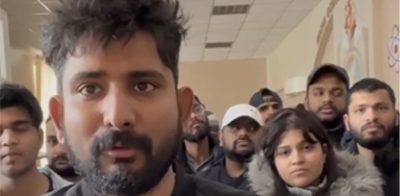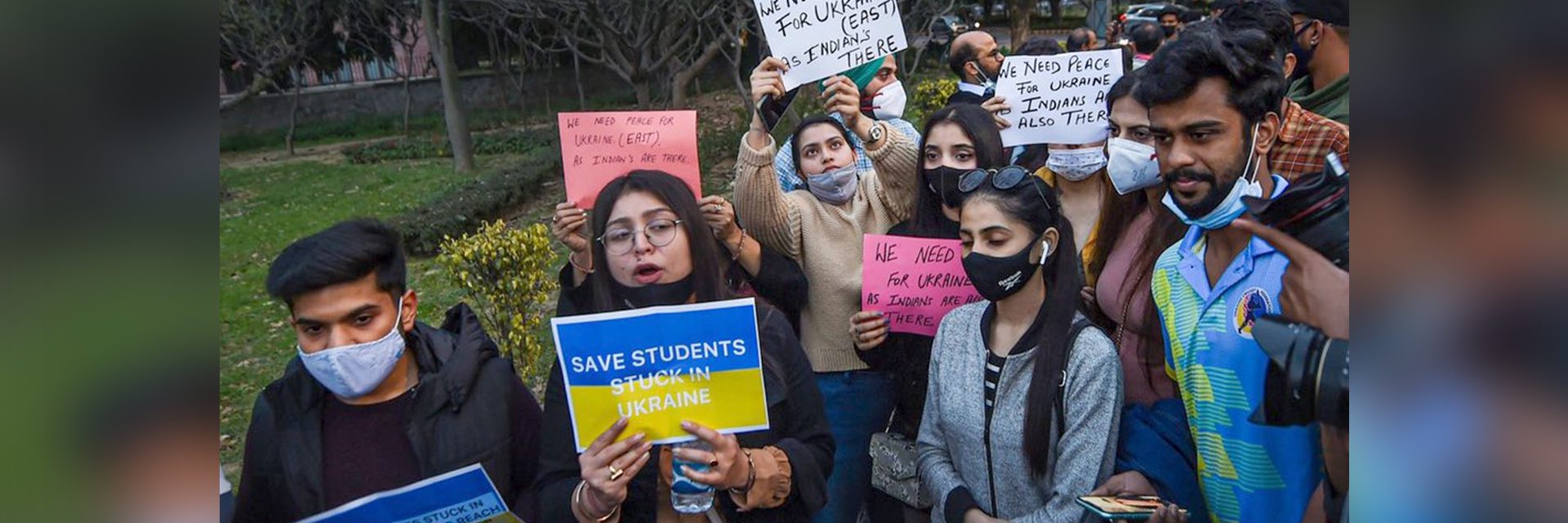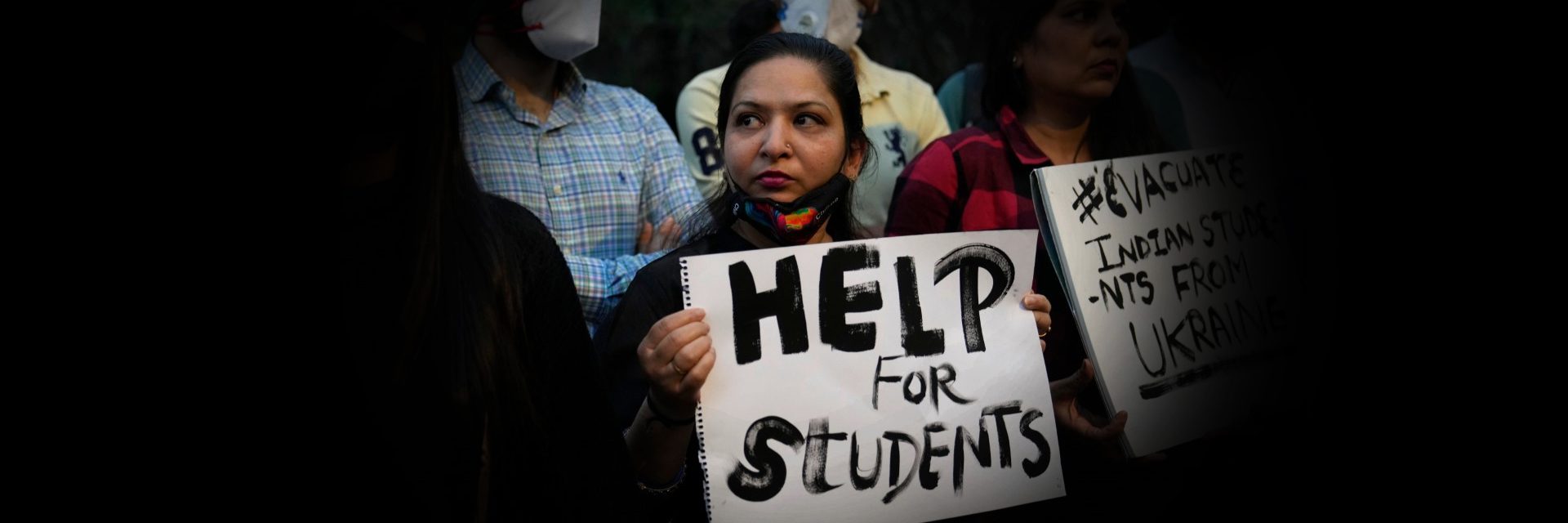(March 11, 2022) For the most part of the day, Mohammed Mahtab Raza had his eyes fixated to the skies – sometimes peeping out of his hostel window or tiptoeing out into the open area. Once it turned dark, the 23-year-old, one among scores of Indian students in Sumy, Ukraine, turned into a “spotter” of sorts, tracking the path of each cruise missile illuminating the skies over the university town. “This one is coming towards us? Look close… everyone take shelter, quick, brace,” he yelled, pointing a finger at what appeared to be an incoming missile, dead in the night.
Even as Raza and the other students brace for the attack inside the dingy basement of their hostel complex, luck once again favours them as the aerial bomb lands a few buildings away with a bang. Prayerful yet terrified, students stare at the huge ball of fire, and smoke billowing. It was just another day in the lives of the 600-odd students evacuated from the war zone of Sumy after 12 days of Russia’s brute force across Ukraine.
Raza, who has been posting developments on his Twitter page, describes huge explosions heard from their dorm room, where the students have been in hiding. On March 7, he tweeted that evacuation plans had fallen through, saying, “everyone is frightened,anxious.immediat evacuation. no light,no water, no ways to contact family…” (sic).
3.02.22,7:pm,huge explosion near international students hostel.everyone is frightened,anxious.immediat evacuation. no light,no water, no ways to contact family,@PMOIndia @JM_Scindia @RahulGandhi @ravishndtv @aajtak @ABPNews @ArnabGoswamiRTv @AncaVerma#savesumytudents #US pic.twitter.com/g9bWAPKEfx
— IamMahtab (@DudeMahtab) March 4, 2022
Evacuation from Sumy had been stalled, however, and on March 8, a day after Mahtab’s final tweet, the Indian ministry of external affairs confirmed that all students had been shifted out. Seen as one of the most complex parts of the evacuation, 500 students were shifted out from Lviv, in specially arranged trains that will take them to Poland. They were seen off at the station in Lviv by Partha Satpathy, the Indian envoy in Ukraine.
Frustrated and tired after the most harrowing time, the near-death experiences faced by these Indian students in the Sumy war zone helped some emerge stronger, wiser as they perfected the art of survival. But there are others who showed signs of depression, requiring medical help for mental health issues once back in their homeland.
“The experiences of the past 12 days have taught us a lot. Throughout these most difficult and challenging times, we helped each other and stood by each other. We shared our problems, and laughed away our troubles, which kept our spirits high,” informs Mahtab, a fourth year MBBS student in Sumy Medical University, in an exclusive interview with Global Indian, hours before hopping onto a bus to Poltava, and onward by train to Western Ukraine.
From keeping track of assaults from air and ground, food and water was scarce, and the sub-zero temperatures were cruel – These MBBS students from different parts of India were on a mission impossible every day as death hovered across Sumy and Ukraine, especially during the nights when the eerie silence was punctured by the deafening air strikes and intermittent firing.

Raza was one among hundreds of Indian students in Sumy Medical University, Ukraine
Hailing from Motihari, East Champaran district in Bihar, Mahtab became the most visible face among stranded students. His initiatives – making multiple videos of the deteriorating situation, as he articulated problems, forwarded to the authorities, the Indian embassy and government officials finally reacted. Desperate pleas for immediate evacuation were finally heard.
“There were massive air strikes around us. We heard two blasts at 5 am, which shook all of us. There were heavily armed people patrolling the streets. Once the air strikes started, there was no electricity or water, and a severe shortage of food. We wanted to flee but the railway tracks were damaged in the air strikes, there were no buses or taxis. We were scared and anxious,” informs the 23-year-old, who has been studying in Sumy since 2019. “We could see a missile hitting our university,” he added.
The Sumy evacuation was the most complex for Indian authorities as both the warring nations stood their ground, delaying the operation. Though Russia announced a humanitarian corridor, it was not honoured, making it impossible for anyone to move out. Going by various reports, about 21 people died, and scores were injured in Sumy alone.
Indian students at a bunker in Sumy, Ukraine. Picture shared by one of the Indian students. pic.twitter.com/tJWVJ132zM
— Sidhant Sibal (@sidhant) March 4, 2022
Many students had lost hope. Some blamed government, others left on their own, even if it meant facing death. Students helped cheer each other during these tough days indulging in light hearted conversations, which helped lighten the tense atmosphere at the hostel.
“Some students will face PTSD for sure. The deafening sound of bomb blasts, intermittent gunfire was disturbing. Lack of sleep, unhygienic conditions in the washroom due to lack of water, no electricity, consuming stale food, contaminated water and fading hopes of evacuation plunged many into depression,” disclosed another Indian student in Sumy. She herself was unwell at the time of safe passage.
“Some students felt death was certain, and a painful one. This was just after the death of Naveen Shekharappa in Kharkiv,” she says, adding that many would cry inconsolably. Some even alleged that they were being used as human shields.
Breaking: India's Ministry of external affairs confirm that it has been able to move out all Indian students from Sumy; They are currently en route to Poltava, from where they will board trains to western Ukraine.
Picture from earlier today while leaving Sumy pic.twitter.com/2ize1chONh
— Sidhant Sibal (@sidhant) March 8, 2022
In fact, 24 hours before they were finally taken to safety, many had hopped onto buses when the Indian embassy officials dropped the plan as the ceasefire had been violated through the humanitarian corridor, which led to great disappointment. They walked back to the death knell. Now, safe, they are desperate to return home. However, with efforts resuming smoothly, the 500-odd students in Sumy who went to Poland by train, were expected to arrive in India on March 10.
- Follow Mohammed Mahtab Raza on Twitter



